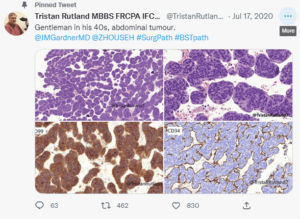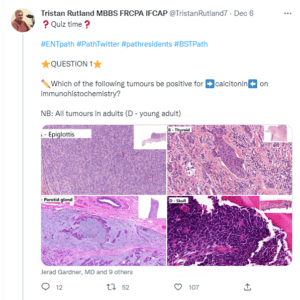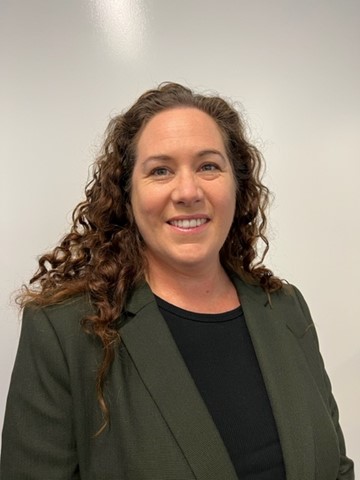Media Resources & Contact

Social media generally, and in particular platforms like Twitter, have been variously described as a bin fire, a sewer and a place for trolls. So why choose it as a platform for education?
Who better to ask than Dr Tristan Rutland, NSW Health Pathology anatomical pathologist, and the recent recipient of a prestigious US award for his selfless dedication to pathology education.
Dr Rutland is also very popular on Twitter. He’s no Elon Musk, but Tristan Rutland (@TristanRutland7) has over 12,000 followers and his use of the social networking platform to share and discuss images of pathology slides has attracted a devoted worldwide following.
The winner of the 2022 College of American Pathologists Resident Advocate Award and the 2020 Konrad Muller RCPA Outstanding Teaching Award explained how the COVID pandemic fired his interest in what’s known as #PathTwitter – an international community of pathologists sharing cases and educating each other on how to avoid diagnostic pitfalls.
“When the pandemic kicked off I ended up teaching our registrars via digital, and that expanded to the point where I was teaching pretty much all the registrars in Australasia in the RCP training program every Saturday for four hours for six months,” Dr Rutland explained.
“Then I had a couple of them saying, ‘You should get involved in Twitter’.
“Now, social media has always been a bit of a bin fire, or a dumpster fire, for me. It was always frustrating and people getting angry very quickly, so I just stayed clear of it. But then somebody introduced me to #PathTwitter and it’s just completely the opposite of all that.
“Marketing people would say, ‘it’s where the people are at’ – and it turns out Twitter is actually one of the most perfect platforms for pathology.
“You have to be succinct, and you can show images, and that’s what people want.
“We’re busy people. People can read what I post for two, three minutes, and in a busy world it just seems to work.”

Dr Rutland has a theory about why the medical community, and pathologists in particular, seem to have avoided the nastiness that has come to be synonymous with social media.
“We’re all doctors who already have a certain level of ethical behaviour,” he said.
“People who choose to engage on Twitter in this educational capacity tend to be sort of more dynamic, forward-thinking and will probably not want to engage in (nasty behaviour), that’s not their forum.
“People tend to be quite professional and very supportive. I also have patients and other professionals following me so I’m always very aware of my behaviour.”
Dr Rutland is also very keen to emphasise that the sharing of information is done without any identification of patients.

He only shares images of cases that are years, if not decades old, to avoid any connection to patients and it’s all de-identified.
“The whole idea is not to talk about the patient. It’s about discussing the pitfalls and the things that are important for someone to learn and make a diagnosis.
“What do you think this possibly could be? What are the pitfalls and how do you get around it, a bit of a discussion about how you could avoid making this mistake and potentially do a disservice for your patients.
“Particularly with unique cases, then there’s a big, big, time lag. If something is super rare, you wouldn’t put it up the next day, you’d wait a year.”
As much as he enjoys passing on his knowledge, Dr Rutland says he’s also learned from other people sharing their cases.
“I do it because I enjoy teaching and I also get something out of reviewing my older cases, but I have to admit I have been saved and people in our department have been saved by stuff that people have put up on Twitter.
“I’ve actually been like, ‘Yes, I’ve seen something like this’, and it’s changed a diagnosis.”
More than that, the platform has changed the way he collaborates with colleagues around the world, opening up new opportunities for learning and research.
“Absolutely. I’ve just got an abstract accepted for USCAP (United States and Canadian Academy of Pathology), which is over in the US next year, and I’m one of about 60 pathologists that have never met in person, haven’t had a zoom call – it was all through Twitter,” he said.
“There are people putting out calls for papers and collaboration on Twitter, for people to get involved in research articles, to be involved in new projects and new initiatives. It’s completely changed the way people collaborate.
“I had no idea this would actually be such a powerful tool.”
He hopes the visibility of the #PathTwitter community will attract more people to pathology, a specialty struggling for numbers worldwide.
“The irony is we are one of the most active medical communities on social media, yet it’s still very difficult to attract people. We have trouble getting people into our training courses and that’s a real shame.
“It’s figuring out how to translate what we do here into, not necessarily engaging the general public, but increased recognition in the medical world.”
He acknowledges pathology is not often viewed as a “sexy option” for medical students but insists that reputation is not deserved.
“If I had my time again, I’d do pathology again. It’s such a great specialty because it’s super interesting. People go, ‘You’re just looking at little glass slides’, but once you know what you’re looking at, it’s actually really engaging, one of the most engaging things I’ve done in my life.”

